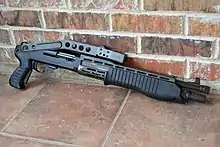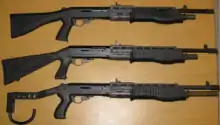Franchi SPAS-12
The Franchi SPAS-12 is a combat shotgun manufactured by Italian firearms company Franchi from 1979 to 2000. The SPAS-12 is a dual-mode shotgun, adjustable for semi-automatic or pump-action operation. The SPAS-12 was sold to military and police users worldwide, as well as on the civilian market, and has been featured in many films, TV shows, and video games.
| Franchi SPAS-12 | |
|---|---|
 The Franchi SPAS-12 with stock folded and butt hook removed | |
| Type | Combat shotgun |
| Place of origin | Italy |
| Service history | |
| In service | 1979–present |
| Used by | See Users |
| Production history | |
| Designer | Franchi |
| Designed | 1979 |
| Manufacturer | Franchi |
| Produced | 1979–2000 |
| No. built | 37,000 |
| Variants |
|
| Specifications | |
| Mass |
|
| Length |
|
| Barrel length |
|
| Cartridge | 12 gauge 23⁄4 inch shells only |
| Action | Pump-action/gas-actuated |
| Rate of fire | Semi-automatic or pump action |
| Effective firing range | Dependent on ammunition used |
| Feed system | Tube Extension 5+1, 6+1, 7+1 and 8+1 rounds, internal tube magazine |
| Sights | Iron sight |
The appearance and intended purpose of the SPAS-12 initially led to its "military" designation as a combat shotgun. The SPAS-12 was designed from the ground up as a rugged military shotgun, and it was named the Special Purpose Automatic Shotgun. In 1990, Franchi renamed the shotgun the Sporting Purpose Automatic Shotgun, which allowed continued sales to the United States as a limited-magazine-capacity, fixed-stock model until 1994. Following the United States Federal Assault Weapons Ban, imports of SPAS-12 shotguns to the United States were stopped. In September 2004 the ban expired, but Franchi had ended production of the SPAS-12 in 2000 to focus on the manufacturing of the SPAS-15 model. The SPAS-12's factory retail price in its final year was US$1,500 averaged for its final sales outside the United States to non-restricted countries.[1]
Design
The SPAS-12 was designed to function primarily in semi-automatic mode, with the pump-action mode used to reliably fire low-pressure ammunition such as tear gas rounds or less-lethal bean bags. The firing mode is switched by depressing the button under the fore-grip and also sliding the fore-grip forwards or backwards until it clicks into position allowing the rotating sleeve to open or close the two gas ports.
The SPAS-12 has a magazine cut-off feature, which prevents loading a new round from the internal magazine when the gun is cycled. This lets the operator load a specialized round into the chamber without firing the whole magazine first. A unique feature of the SPAS-12 was the hook on folding-stock variants. This hook could be rotated in 90-degree increments, so it would fit under the user's forearm when the stock was extended. In theory, with the stock supported under the forearm, the gun can be fired with one hand; an example would be letting the user fire from a vehicle through the passenger-side window while driving.
SPAS-12 models feature two safeties: (i) a lever style or push button style safety, and (ii) a "quick employment safety". Lever safeties were recalled by Franchi and were replaced through the importer American Arms in the early 1990s.[a] There are two types of push-button safeties. The earliest version would release the hammer on safe up to 1/4in. of travel when the trigger was depressed; this would cause a lockup of the action that would require the user to re-lock the bolt assembly to the rear to reset the hammer and then reload the chamber. The later version installed a detent and machined hole in the trigger group frame to prevent an action lock; the detent would prevent the hammer from engaging when the trigger was depressed and would prevent an action lock from occurring. The quick employment safety, which is on the left side of the trigger guard, disconnects the trigger when put into safe mode. The quick employment safety can be disengaged with the trigger finger when ready to fire and is intended for competition or tactical use. A third safety type, a pistol grip safety similar to the later-developed SPAS-15, is known to have been developed by Franchi for the SPAS-12, however the pistol grip safety was not offered for sale to the general public.


A B-Square rail mount for optics was available for a short time in the 1990s as an aftermarket accessory.
The barrel of the SPAS-12 was externally threaded to accept a variety of attachments. The barrel is cylinder bored and spreads a normal shot charge to about 900mm at 40 meters.
There are four different Magazine Extension Tubes manufactured for the SPAS 12:
- The 5-shell was designed for the 18" barrel.
- The 6-shell was designed for restriction on the standard 21.5" Sporting Purpose model.
- The 7-shell was designed for the 19 7/8in. Barrel.
- The 8-shell was designed for the 21.5 Special purpose model.
Many choke types original and aftermarket exist for the SPAS-12.[2] A 44mm grenade launcher used by France was used for explosive grenades capable of a range of 150 meters.[3] A factory shot diverter that spreads shot vertically or horizontally was originally included with earlier model SPAS-12's, There are many known reproduction diverters.[4]
SPAS-12, SAS-12 and LAW-12 Model Differences



Four different stock styles exist. The first version of the SPAS-12 manufactured with the wooden detachable stock with the standard grip. Models were later available with the folding metal stock with hook. A rare aftermarket Choate skeleton stock (Approx: 150-180 Choate stocks Manufactured for the shotgun)[5] with an AR15 style grip was available for a short time in the early 1990s. After the United States imposed import restrictions on the SPAS-12 in 1989, a version was released in 1990 with the synthetic hollow fixed stock and a six shell capacity to comply with federal regulations for sporting purposes.
Four different factory barrels manufactured for the SPAS-12.
- (Very Rare) 18-inch (46 cm) "shorty" made for Law Enforcement/Military originally distributed mainly in France. This is the only known model to receive the pistol grip safety.[6]
- (Very Rare) 19-7/8 in. found scattered on a very few of the 1983 "AL" proofed SPAS-12 Shotguns. These were made for Law Enforcement/Military originally.
- (Common to the United Kingdom) 21-1/2" as a one piece barrel converted to a 24" UK legal barrel. This barrel adds with a 2.5-inch (6.4 cm) choke tube brazed or silver-soldered in place).[7]
- (Most Common) The standard 21-1/2" with sight blade muzzle ended on barrel for the special purpose model or the pushed back sight blade with brazed extension for the sporting purpose model.
The Franchi SPAS-12 came equipped with a non-adjustable circular aperture rear sight and a large, non-adjustable blade foresight integrated into the barrel. The LAW-12 was a semi-automatic only and the SAS-12 was a pump action only. These three "sister" shotguns accepted all SPAS-12 components, notably trigger groups, barrel threaded attachments and stocks. The various magazine extension tubes of the LAW-12 and SAS-12 were never designed to be interchangeable with the SPAS-12 as this would cause issues with the gas selector switch moving from Auto to Pump action on the SPAS-12 model.[8] The extensions have been known to spin off the front of the SPAS-12 during cycling if the extension was not tapered for the SPAS-12 retaining pin.
The SPAS-12 collector shotguns are wanted for certain style features.
- The front sight blade is muzzle ended.
- The longer extension allowing eight shells in the tubular magazine.[8]
- The date code on the receiver is proofed 1989 or earlier with F.I.E. (Firearms Import and Export) Corporation as importer.[9]
- The barrel length is 21.5 or less and the less barrel length by factory is more sought after.
- Attached stock is the wooden detachable with grip and or the metal folding stock with hook.
The Pump Only Franchi SAS-12 could accept 3" shells but it did not have a bolt handle cut in the bolt body. The SPAS and LAW could only accept 23⁄4" shells. The SAS 12 has a barrel length of 21.5" an overall length of 41.5" a weight of 7 lbs. 4 oz. and a capacity of 8 rounds in the magazine + 1 in the chamber.
The semi-automatic Only Franchi LAW-12 Model was also restricted by importation in 1989 and banned in 1994 with the AWB. The LAW-12 has a barrel length of 21.5" a weight of 7 lbs. 4 oz. and a capacity of 8 rounds in the magazine + 1 in the chamber. The model was known to have imported with all stock styles used on the Franchi SPAS-12. The LAW-12 models were more common with police sales as an alternative to the more expensive SPAS-12 for departments throughout the United States. The LAW-12 model was notably lighter " 1.35 lbs. " than the SPAS-12 and still maintained the same tube capacity of 8+1 shells. Note Law-12 gas pistons were designed as two piece unlike the one piece design of the SPAS-12, they are not interchangeable. The LAW-12 was discontinued by Franchi shortly before the SPAS-12 discontinued in 2000.
US market
Importers
In the United States, there were two importers of SPAS-12 shotguns. Importation of the SPAS-12 into the United States began in 1982 and ended in 1989 under F.I.E. Corp. In 1989, F.I.E suffered from major losses of sales due to the president's importation ban, which was a reinterpretation of 18 U.S.C. 925(d)(3) that required firearms to have a "sporting purpose" in order to be imported.
In 1990 American Arms incorporated purchased all remaining inventories of parts and SPAS-12 shotguns from the now bankrupt F.I.E Corp and began the re-importation of the Franchi SPAS-12 as the (Sporting Purpose Automatic Shotgun) under newly approved restrictions until 1994. The ATF allowed importation of a SPAS-12 variant from American Arms because its size, weight, bulk and modified configuration were such that it was particularly suitable for traditional shooting sports.[10]
The SPAS-12 was tested by the U.S. Coast Guard and showed promising results but again was not considered cost-effective for a contract over other available suppliers. The Assault Weapons Ban of September 1994 caused American Arms to stop the importation of the SPAS-12 with major losses of sales due to the legal restrictions invoked by the U.S. Assault Weapons Ban.[11]
Both importers placed numerous additional orders for the SPAS-12 that were never completely filled due to U.S. restrictions throughout importation. This was the reason for such few numbers of shotguns imported into the United States.[12]
Legal
A SPAS-12 Shotgun is not an NFA Registry item if it was imported/grandfathered into the United States between 1982-1994 bearing the import markings of F.I.E or American Arms.[b]
A SPAS-12 and LAW-12 shotgun factory stamped by a year after 1994 is considered an illegal import violating federal importation laws with penalties for possession in the U.S. The SPAS-12 would not include Importation Markings on the side of the receiver before 1982 and after 1994 by the U.S. importers Firearms Import and Export (F.I.E) or American Arms.
The 1994 federal "Crime Bill", signed into law by President Clinton on Sept. 13, 1994, included the Violent Crime Control and Law Enforcement Act of 1994. That Act included provisions amending the Gun Control Act (GCA, 1968) to make it a federal crime for a private individual to possess or transfer (sell, give, etc.) an "assault weapon" manufactured after that date. [18 U.S.C. 922(v)]. "Assault weapons" manufactured on or before that date are "grandfathered," meaning that the law does not prohibit their possession or transfer. The law requires that "assault weapons" manufactured after September 13, 1994 be stamped with their date of manufacture or serial number to identify with factory date of manufacturing.[13]
SPAS-12 and LAW-12 shotguns are listed illegal for possession in states that hold a "military assault weapon style" law that identifies the shotguns by name on each states individual ban. The states may have had a registration timeline that would allow it to be grandfathered before each states individual ban. U.S. States and territories listed that ban the Franchi SPAS-12 and LAW-12 currently from future individual civilian possession are, California,[14] Connecticut,[15] District of Columbia,[16] Maryland,[17] Massachusetts,[18] New Jersey,[19] and New York.[20]
Users
 Algeria: Used by the Special Intervention Detachment and the Algerian Special Forces.
Algeria: Used by the Special Intervention Detachment and the Algerian Special Forces. Austria: Used by EKO Cobra.[21]
Austria: Used by EKO Cobra.[21] Bangladesh: Special Security Force.[22]
Bangladesh: Special Security Force.[22] Indonesia: Komando Pasukan Katak (Kopaska) tactical group and Komando Pasukan Khusus (Kopassus) special-forces group.[23]
Indonesia: Komando Pasukan Katak (Kopaska) tactical group and Komando Pasukan Khusus (Kopassus) special-forces group.[23] Ireland: Used by the Army Ranger Wing.[24]
Ireland: Used by the Army Ranger Wing.[24] Malaysia: National Special Operations Force.[25]
Malaysia: National Special Operations Force.[25] Nepal: Nepal Mobile Police[26]
Nepal: Nepal Mobile Police[26] Turkey: Turkish Gendarmerie.[27]
Turkey: Turkish Gendarmerie.[27] United States: Used by police SWAT teams.[28]
United States: Used by police SWAT teams.[28]
Notes
- ^a The push-button cross bolt safety has also been known to fail and release the hammer when depressing the trigger on safe and it is recommended that the secondary Quick Employment Safety (lever tab on left side of trigger) is used on both the newer and older style trigger groups in place of the lever or cross bolt safety's to prevent accidental discharge.
- ^b The LAW-12 and SAS-12 models were known to have no import markings on the receiver but are actually marked by importer on the barrel itself.
References
- Cooney, Chris (June 2002). "Introduction". Retrieved 2010-05-10.
- "SPAS Choke Adaptor". spas12.com.
- "Cibles #164 November 1983". The SPAS 12 Project. Archived from the original on 22 February 2015.
- "Franchi SPAS-12 Factory Accessories". spas12.com.
- "Welcome to Choate Machine and Tool - Your Premier Source for Tactical Stocks and Accessories for Rifles, Shotguns and Submachine Guns". riflestock.com.
- "SPAS-12 -". Guns.com.
- "UK Owner's Letter". spas12.com.
- "Magazine Extension Types". spas12.com.
- "When Was My SPAS 12 Made?". The SPAS 12 Project. Archived from the original on 2015-02-23.
- https://www.atf.gov/files/firearms/industry/january-2011-importability-of-certain-shotguns.pdf.
- "The Coolest Email You'll Read All Day". The SPAS 12 Project.
- "Firearms and Ammunition Technology". atf.gov.
- http://www.gpo.gov/fdsys/pkg/BILLS-110hr1022ih/html/BILLS-110hr1022ih.htm
- "CA Codes (pen:30500-30530)". ca.gov. Archived from the original on 2016-03-04. Retrieved 2015-02-22.
- "WEAPONS BANNED AS ASSAULT WEAPONS". ct.gov.
- "Law Center to Prevent Gun Violence".
- "Gen. 101] 101 FIREARMS May 24, 2010 Colonel Terrence B. Sheridan Superintendent, Maryland State Police You have asked for an int" (PDF). googleusercontent.com. Archived from the original on 2016-04-20.CS1 maint: bot: original URL status unknown (link)
- "Law Center to Prevent Gun Violence".
- "S2497". state.nj.us.
- "NYSAFE Act Gun Reform - Governor Andrew M. Cuomo". ny.gov.
- http://www.bmi.gv.at/cms/BMI_EKO_Cobra/publikationen/files/LawOrder.pdf
- "Bangladesh Military Forces - BDMilitary.com".
- "Kopassus & Kopaska – Specijalne Postrojbe Republike Indonezije" (in Croatian). Hrvatski Vojnik Magazine. Archived from the original on 2010-08-22. Retrieved 2010-06-12.
- Matthew Hogan. "IRELAND'S ARMY RANGERS". Tactical Life Gun Magazine: Gun News and Gun Reviews.
- Thompson, Leroy (December 2008). "Malaysian Special Forces". Special Weapons. Retrieved 2010-02-10.
- Shotgun uses by Nepal Mobile Service police^
- "SÝLAHLAR". jandarma.tsk.tr. Archived from the original on 2014-12-14. Retrieved 2013-12-22.
- McManners, Hugh (2003). Ultimate Special Forces. DK Publishing, Inc. ISBN 0-7894-9973-8.